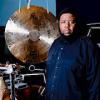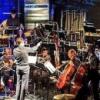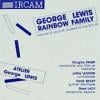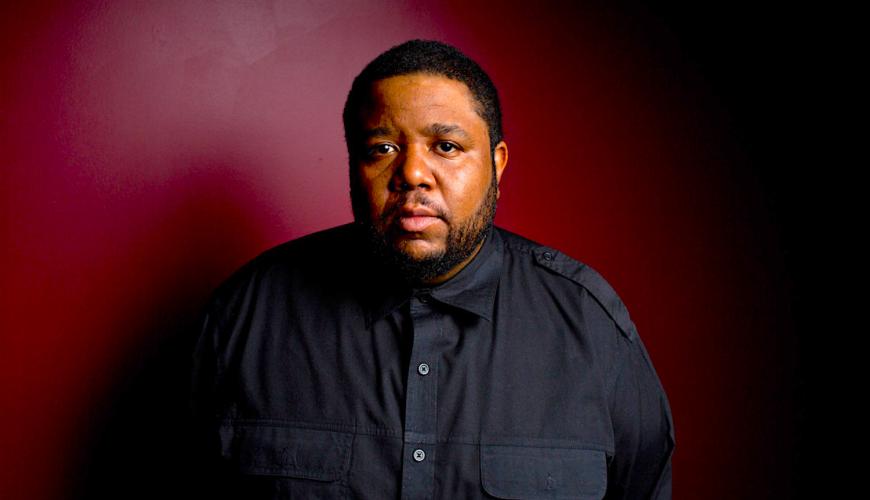
I was, to say the least, moved when I first heard composer and multi-instrumentalist Tyshawn Sorey‘s For George Lewis. As it happens, I was also quite literally moving, seated on a plane slicing through air thousands of feet above ground, listening intently while strapped firmly to a place between places, a time within time.
As I receded into the piece in my headphones, I could feel myself becoming transfixed by the work’s spectral qualities, its hints of cyclicality, its subterranean pulses tectonic in their patience. Amid the jolting mid-flight turbulence, I could feel myself perceiving sonic events emerging from a slow and meticulous development, string and horn and piano figures morphing and layering into unsettled, billowing clouds. Meters appeared and disappeared, overtones combined into unexpected colors, harmony became an increasingly insufficient word to describe the surprising collisions of pitch and timbre. Listening, hurtling across a continent in a state of half-dream, I felt myself being slowly pried open, my attention wavering in step with the piece’s design. And after nearly an hour of implication and withholding, approach and circling, nearly and not yet, suddenly, a single melody arrived, like the shock and comfort of landing.
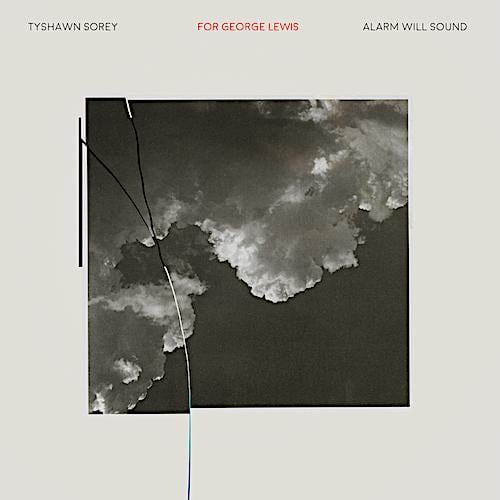
For George Lewis, recorded in collaboration with the virtuosic Alarm Will Sound chamber orchestra, forms one half of a new double album released Aug. 27: For George Lewis | Autoschediasms (Cantaloupe Music 2021). Featuring For George Lewis as well as two striking performances of Sorey’s improvisatory Autoschediasms — one played and recorded in person in 2019, the other choreographed and performed over the internet in 2020 —the album highlights the tight-knit and still-evolving creative relationship between Alarm Will Sound and Sorey. The album also pays tribute to a number of Sorey’s artistic guides, most directly honoring composer and theorist George E. Lewis.
For Sorey — a 2017 MacArthur Fellow, Presidential Assistant Professor of Music at the University of Pennsylvania, and frequent collaborator with other innovative artists including with Vijay Iyer, with whom he collaborated, alongside Linda May Han Oh, on Uneasy (2021), already a top release of the year — For George Lewis | Autoschediasms builds on the lessons and openings of previous musical boundary crossings while stretching into new creative and imaginative soundspace.
Recently, I had the opportunity to speak with Sorey about his new release. In our conversation, he shared his thoughts on what it’s been like collaborating with Alarm Will Sound, the legacies of composer-theorist George Lewis, the value of repeated listening, and, crucially, the deeper meanings behind a key phrase from his liner notes for the album: “the decorating of time.”
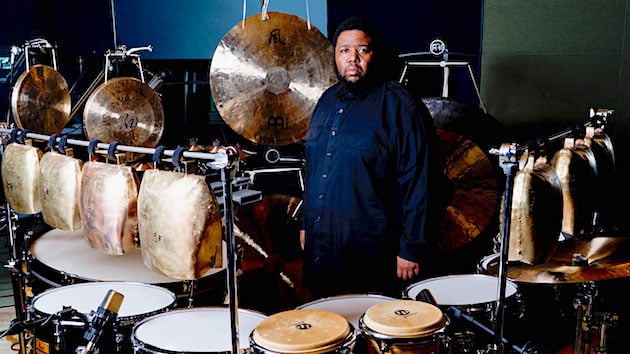
Where do you find yourself working and thinking these days? And how do you feel your environment has been shaping your sound-making practice?
Thank you, it’s great to be here with you. I’m currently based in the greater Philadelphia area in Pennsylvania, teaching at the University of Pennsylvania, but I often also find myself traveling back to New York to compose and collaborate and perform. Both are really incredible cities and environments to work in. Lately it’s been fantastic being able to not only work in my own home, but also in my office, and to collaborate with different people on a fairly regular basis now that things are beginning to open back up.
Absolutely. And speaking of collaborating with others, how did this partnership with Alarm Will Sound come about?
I had wanted to do something with Alarm Will Sound even long before they contacted me. But I would say it was around 2018 or 2019 when our collaboration really started. The ensemble was interested in having me do one of my spontaneous live compositions, Autoschediasms, and when we did it with the group in St. Louis, the performance was very, very successful. At around the same time they also commissioned me to write a work for the ensemble, which is the piece that became For George Lewis.
Now with Autoschediasms — that was an opportunity to learn about some of the players’ abilities and what they typically did in their concert formats. So, what I wanted to do with the subsequent commissioned work was not just to engage with those things they were good at, but also to give them something very different to do, musically, and to tailor it to things I wanted to explore compositionally. Especially when it came to the strings — the string writing, for example, in For George Lewis can be rather intense at times. That was intentional. But to sum it up, in hearing all of the players in Alarm Will Sound, I was sure at that point that my musical interests [meshed] perfectly with theirs, and that they would be able to play just about anything I wanted to write for them.
That makes sense. And with as much trust that has to exist for a work like For George Lewis to be performed well — it seems like Autoschediasms was key to that process of developing a shared sense of comfort.
Yes, it was wonderful. My rule is that I have to trust those with whom I’m collaborating before and during a given work’s creation — spontaneous or notated. When we were in St. Louis together, it immediately felt like we were all a family; I just thought, “You know what? I’m going to be working with these guys for a very long time, if not for the rest of my life.” It was been a great introduction, and to especially have Alan Pierson there being so supportive and Gavin Chuck, the executive director — to have that support system along with an incredible ensemble full of virtuosic players and thinkers who can do anything, it’s amazing.
I felt the same collaborative spirit with Alarm Will Sound that I feel with the International Contemporary Ensemble, with whom I’ve been working for over 12 years now. You get together with people in the room, and the more time you spend with them the more apparent it becomes that they are kindred spirits. When you have that going on, there can be no wrong done, and the trust we have for each other is mutual.
Shifting over to the double album now — I really noticed on my second listen that there are three distinct modes of co-producing sound at play on the project. There’s the very meticulously composed and crafted For George Lewis; there’s the in-person Autoschediasms performance from St. Louis in 2019; and then there’s the virtually choreographed Autoschediasms, which had its own unique challenge-opportunities and is mixed on the album to flow seamlessly out of. the in-person performance. Looking back, what does it mean for you that these three different compositional and performance approaches all coexist on the same album?
I think that coexistence reflects the ways I like to work. All of these are ways in which I like to work with groups, and also logical extensions of what I actually do in practice as both a listener and a composer of notated and spontaneous material. Sometimes my notated material can be extremely meticulous — its harmonic content, its rhythmic content, the way that the composition is put together and who it’s informed by, who gets to play it, a number of other factors. That can be a very meticulous world. The same thing can apply to my spontaneous compositions, where there is a purpose for everything that is crafted in real time.
I’m always thinking very much about form, and about scope, and about scale, and about structure — about getting into these different modes of music-making with others on the spot, but also with the same amount of attention, skill, and thought that I would have to exercise into my notated works. I think this new record reflects that.
For the virtual component — that version of Autoschediasms was the first time I’d gotten to create anything like that. But I had long wanted to participate in live collaborations that were mediated by the internet. I know a lot of incredible improviser-composers who were exploring this kind of music making as I was becoming more and more involved with contemporary ensembles like Alarm Will Sound. George Lewis, David Wessel, Mark Dresser, and Michael Dessen, among several others, are pioneers in this medium who did these tele-performances long before this pandemic even happened. Thinking about the history of that and after Alarm Will Sound approached me about this idea, I thought “Why not engage this medium using Autoschediams language and see what that feels like?”
As one who is not very technologically inclined, it was definitely a challenge and a learning experience for me, and one that I will definitely continue to value and carry forward, especially into other possible real-time creations over the internet with people from different parts of the country. I hope to do more of that again, at some point.
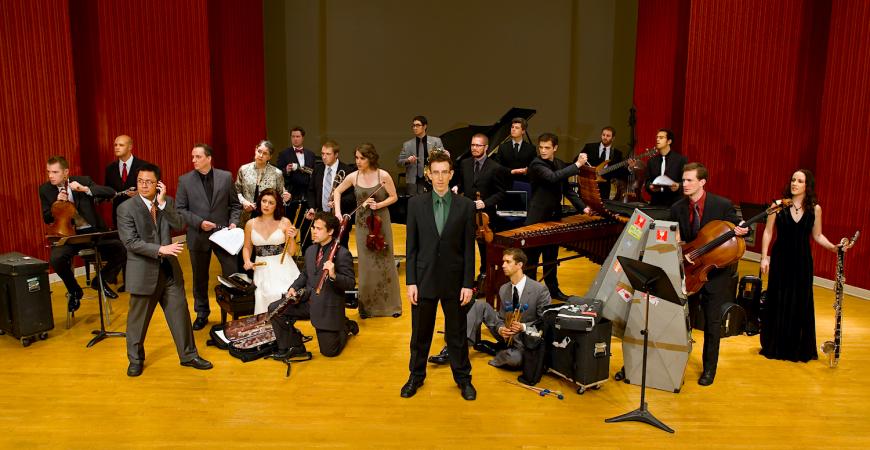
Circling back now: you mentioned earlier your attention to structure, and it brought to mind for me a phrase you use in your liner notes: “the decorating of time.” Would you tell a bit about what that idea means for you personally? Where it comes from?
Well, it really comes from George Lewis’s The Will to Adorn. From a technical, structural, and musical level — when I first experienced the world premiere of that piece — it had, and still has, a profound, lasting influence for me. It was an incredible display of how Lewis deals with timbre, how he deals with different modes of ensemble behavior, how he puts all these different types of structure together within a single form. It was incredible to witness.
Now I bring up George’s piece because the word “adorn” in the title really stuck out to me, especially once I heard the composition. In fact, he himself was once talking about how adornment, in principle, is very much aligned with his compositional attitude, as well as this idea of instability, even within his ensemble situations. Nothing is ever really quite the same in those settings. There’s sometimes even the feeling of potential breakdown because there’s so much complex material in the music — such that even the performer at times has to technically negotiate its execution. So, when I’m thinking of adornment as a principle, I’m thinking of that on a temporal level.
Every composition since my experience with The Will to Adorn addresses this principle in various ways. For me, any time I’m given a length of time in which to come up with something, I’m always viewing myself as decorating a home. “Here are these blank rooms. What do I do with them? Do I leave certain rooms as they are? Which ones do I decorate?” That’s how I view temporality; the decorating of time. You’re only given this one chance to do that. You’re only given this one opportunity to envelop the listener in this space, where they have this finite amount of time to walk around the space and observe what’s in it, what it smells like, the temperature ... What do they notice? What is there beyond the surface? When I say “the decorating of time,” that’s what I’m more-or-less referring to.
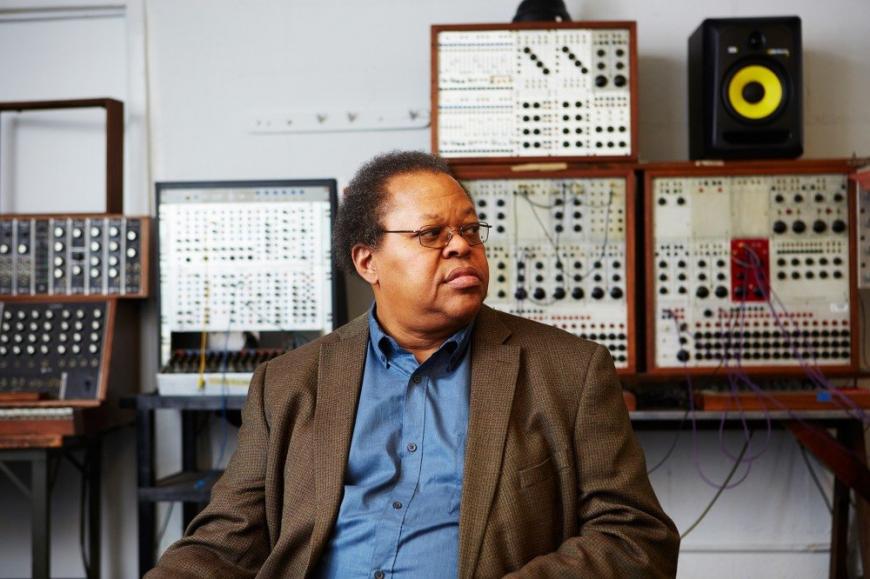
I should also mention that I was also thinking about these ideas when I did a spontaneous-composition with Marilyn Crispell titled The Adornment of Time, which is a 65-minute piece we’ve performed on stage together and released as a CD on Pi Recordings in 2019. With that work, it was the situation as I described before, where we were given this length of time, and we got to decorate it, to get deep inside of what it meant to exist in that roomful of time together. That’s what it’s all about for me.
I can definitely hear what you mean, harmonically, rhythmically, and texturally, after having listened to this latest record a number of times. There’s a strong spatial quality. And yet there are also these lines or arcs of intensity. One moment that moves me on every repeat listen to For George Lewis, for instance, is the emergence of a slowly unfurling horn melody after over 40 minutes of tricky harmonies and timbral developments and glacial rhythmic cells. When I first heard the horns come forward, my metaphorical brain began to recast the piece as an allegory for the emergence of atoms; you have this original state, and then this bang that creates time, and then, over time, you get this sense of — not “order,” per se, but something emerging.
Yes, that sounds right. And you know, that’s what George Lewis’s work is all about. His music is legendary for its feeling of emergence. Going back to The Will to Adorn, you have motives and melodic/timbral passages that emerge out of these contrasting sonic events that take place. During the last few minutes of that piece, for example, there is a long melodic motive that emerges out of this incredibly complex, contrapuntal, high intensity structure that sounds like a constellation of activity performed by all of the musicians. There’s also another George Lewis composition, Emergent, where again you have that same principle of things emerging — the player emerging from the electronics, the electronics emerging from the player, etc. That’s what George’s work is to me. With my piece, I wanted to adopt that principle temporally and melodically through my love of sonority. And as a dedication composition, I felt that element of emergence was very important.
Looking ahead, what do you hope for listeners as they engage with this new double album?
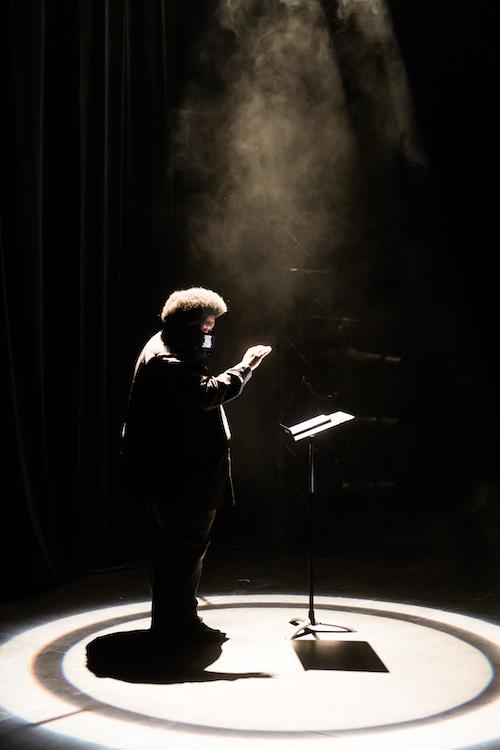
I don’t think people should go into it with any expectations that the piece is in some way a stylistic or mimetic homage to George Lewis’s music. Because in fact my music sounds very, very different from his. The same goes for some of my improvisational sensibilities when I’m creating work spontaneously. Yet at the same time, the record is — in whole — a dedication to Lewis that runs beyond the scope of the title track. It’s really thinking about his life and his work, and also how he has been there for me as a mentor and as a teacher who I’ve worked with for a number of years. I would want the listener to register that, but then to appreciate the music simply for what it is, rather than putting some expectation on it before they listen. I think that’s the best way to fully experience the work — without expectation. Because the more you go into it without expectation, the more you’re able to decide how you’re going to listen to it and how you’re going to appreciate it as it is unfolding. Really, for a lot of my music, I just like for the listener to think about what it means to experience music rather than simply listen to it. Because to me, there’s a difference between listening to music and experiencing it.
What I want the listener to do is just to let the music wash over them. My hope is that they’ll enjoy it. I want the listener to really come away with questions and further curiosities as it concerns their appreciation of the music and their thoughts behind it; it’s important to me as a maker of music that one’s consciousness is to some degree expanded after a given work’s experience.
That’s fantastic. This new record has certainly spoken to me, as a listener. It rewards multiple listens; new things emerge every time. I know I’ll grow alongside it.
Definitely. That’s something worthy of note, too. I think this music will require those multiple listens as you mention. I don’t think anybody would fully get what’s going on with one listen alone. There’s a lot more to it than what’s on the surface. A listener will always find something new that they didn’t discover upon the first or second or fifth or 20th listening. It’s a really good point.
Always another angle, another way of seeing something in that room, right?
[Laughs] Yes, exactly.


